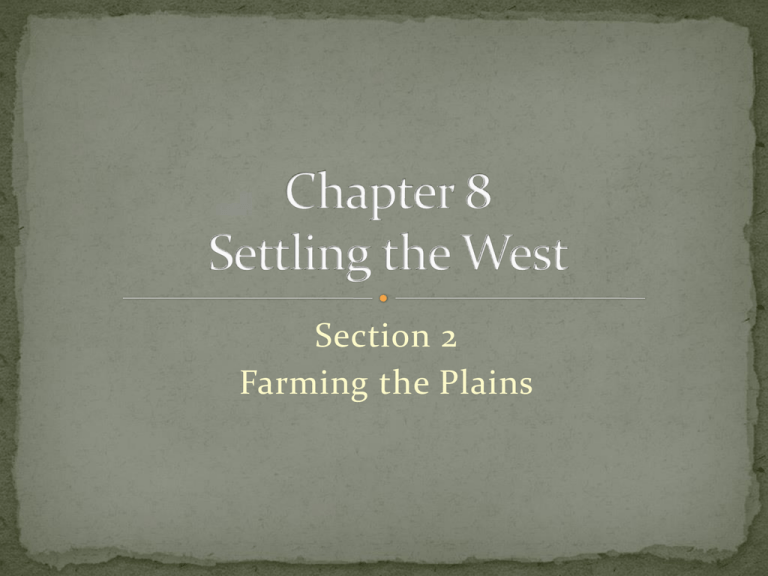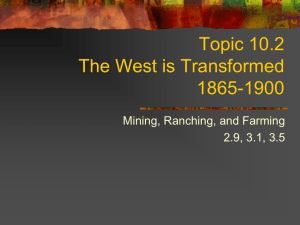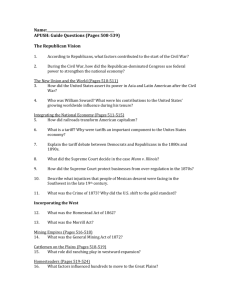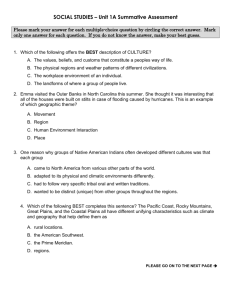8-2 Farming the Plains
advertisement

Section 2 Farming the Plains Guide to Reading Main Idea After 1865, settlers staked out homesteads and began farming the Great Plains. Key Terms and Names • Great Plains • dry farming • Stephen Long • sodbuster • Homestead Act • Wheat Belt • homestead • bonanza farm Click the mouse button or press the Space Bar to display the information. Guide to Reading (cont.) Reading Strategy Organizing As you read about the settlement of the Great Plains, complete a graphic organizer similar to the one on page 292 of your textbook listing the ways the government encouraged settlement. Reading Objectives • Explain why and how people began settling the Plains. • Trace the growth of commercial farming on the Plains. Click the mouse button or press the Space Bar to display the information. Guide to Reading (cont.) Section Theme Science and Technology The need for new farming techniques in the West led to several technological innovations. Click the Speaker button to listen to the audio again. Geography of the Plains • The Great Plains region extends westward to the Rocky Mountains from around the 100th meridian–an imaginary line running north and south from the central Dakotas through western Texas. • Rainfall on the Great Plains averages less than 20 inches per year. • Trees only grow naturally along rivers and streams and on hilltops. • Huge herds of buffalo once grazed on the prairie grasses of the Great Plains. (pages 292–293) Click the mouse button or press the Space Bar to display the information. Geography of the Plains (cont.) • Major Stephen Long explored the Great Plains with an army expedition in 1819. • He called it the “Great American Desert” and said it was almost entirely unfit for farming. (pages 292–293) Click the mouse button or press the Space Bar to display the information. Geography of the Plains (cont.) What is the geography of the Great Plains? The Great Plains region extends westward to the Rocky Mountains from around the 100th meridian–an imaginary line running north and south from the central Dakotas through western Texas. Rainfall averages less than 20 inches per year. Trees only grow naturally along rivers and streams and (pages 292–293) on hilltops. Click the mouse button or press the Space Bar to display the answer. The Beginnings of Settlement • Railroads provided easy access to the Great Plains. • Railroad companies sold land along the rail lines at low prices and provided credit. • The federal government helped settle the Great Plains by passing the Homestead Act in 1862. • For $10, a settler could file for a homestead, or a tract of public land available for settlement. Click the mouse button or press the Space Bar to display the information. (page 293) The Beginnings of Settlement (cont.) • The homesteader could get up to 160 acres of public land and could receive title of it after living there five years. • Settlers on the Plains found life very difficult. • The environment was harsh, with summer temperatures soaring over 100°F and winter bringing blizzards and extreme cold. • Prairie fires and swarms of grasshoppers were a danger and a threat. Click the mouse button or press the Space Bar to display the information. (page 293) The Beginnings of Settlement (cont.) How did the railroads and the federal government help settle the Great Plains? Railroads provided easy access to the Great Plains. Railroad companies sold land along the rail lines at low prices and provided credit. The federal government passed the Homestead Act in 1862. For $10, a settler could file for a homestead. The homesteader could get up to 160 acres of public land and could receive title (page 293) of it after living there five years. Click the mouse button or press the Space Bar to display the answer. The Wheat Belt • Many inventions and new farming methods made farming on the Great Plains very profitable. • Farmers on the Great Plains used the dry farming method–planting seeds deep in the ground where there was enough moisture for them to grow. • By the 1860s, farmers on the Great Plains were using newly designed steel plows, seed drills, reapers, and threshing machines. (pages 294–295) Click the mouse button or press the Space Bar to display the information. The Wheat Belt (cont.) • These machines made dry farming possible. • Farmers could work large tracts of land with the machines. • Farmers who plowed the soil on the Great Plains were called sodbusters. • Many of them lost their homesteads because of drought, wind erosion, and overuse of the land. (pages 294–295) Click the mouse button or press the Space Bar to display the information. The Wheat Belt (cont.) • During the 1860s and 1870s, new technology, such as the mechanical reapers and binders and threshing machines, made farming more profitable. • The innovations were also well suited for harvesting wheat. • Wheat withstood drought better than other crops, so it became the most important crop on the Great Plains. (pages 294–295) Click the mouse button or press the Space Bar to display the information. The Wheat Belt (cont.) • Wheat farmers from Minnesota and other Midwestern states moved to the Great Plains in large numbers to take advantage of the inexpensive land and the new farming technology. • The Wheat Belt began at the eastern edge of the Great Plains and included much of the Dakotas and the western parts of Nebraska and Kansas. (pages 294–295) Click the mouse button or press the Space Bar to display the information. The Wheat Belt (cont.) • Some wheat farms, called bonanza farms, were much larger than single-family farms and covered up to 50,000 acres. • These farms often brought the owners large profits. • Several events caused Great Plains farmers to fall on hard times. • In the 1890s, a glut of wheat caused prices to drop. (pages 294–295) Click the mouse button or press the Space Bar to display the information. The Wheat Belt (cont.) • Some farmers lost their land because they could not repay bank loans they had taken out. • A prolonged drought that began in the 1880s forced many farmers to return to the East. (pages 294–295) Click the mouse button or press the Space Bar to display the information. The Wheat Belt (cont.) Why did much of the Great Plains region become the Wheat Belt? Wheat withstood drought better than other crops, so it became the most important crop on the Great Plains. Wheat farmers from Minnesota and other Midwestern states moved to the Great Plains in large numbers to take advantage of the inexpensive land (pages 294–295) and the new farming technology. Click the mouse button or press the Space Bar to display the answer. Closing the Frontier • In 1890 the Census Bureau reported that the frontier was closing. • This news concerned those who believed that land at the frontier provided a place for Americans to make a fresh start. • Many settlers in the Great Plains did make a fresh start. • They adapted to the environment by getting water from deep wells and getting supplies and building materials that the (page 295) railroads had shipped. Click the mouse button or press the Space Bar to display the information. Closing the Frontier (cont.) Why was the Census Bureau’s report of 1890 disturbing to some people? The news that the frontier was closing concerned those who believed that the frontier offered a place for Americans to make a fresh start. (page 295) Click the mouse button or press the Space Bar to display the answer. Checking for Understanding Define Match the terms on the right with their definitions on the left. __ A 1. method of acquiring a piece of U.S. public land by living on and cultivating it A. homestead C 2. a name given to Great Plains __ C. sodbuster farmers D __ 3. a large, highly-profitable wheat farm B __ 4. a way of farming dry land in which seeds are planted deep in the ground where there is some moisture Click the mouse button or press the Space Bar to display the answers. B. dry farming D. bonanza farm Checking for Understanding (cont.) Explain why the Great Plains was not suitable for homesteading. Geography and climate made the Great Plains not suitable for homesteading. Click the mouse button or press the Space Bar to display the answer. Reviewing Themes Science and Technology How did the need for new farming techniques on the Great Plains result in technological innovations in agriculture? Mechanical reapers, binders, and threshing machines were all created to help farmers harvest large tracts of farmland quickly. Click the mouse button or press the Space Bar to display the answer. Critical Thinking Analyzing What factors contributed to the making of the Wheat Belt in the Great Plains and then to troubled times for wheat farmers in the 1890s? The Homestead Act and new farming techniques and equipment helped develop the Wheat Belt. Good harvests and world competition caused a glut that caused prices to drop. Click the mouse button or press the Space Bar to display the answer. Analyzing Visuals Examining Photographs Study the photograph on page 293 of your textbook of farmers using binding machines in western Wisconsin. Based on the terrain and the type of work they needed to do, what other types of technology would have helped farmers on the Plains? Possible answer: Windmills would have helped by supplying power and irrigation. Click the mouse button or press the Space Bar to display the answer. Close Study commercial farming in the Plains.





